Cockatiel
| Cockatiel | ||||||||||||||||
|---|---|---|---|---|---|---|---|---|---|---|---|---|---|---|---|---|
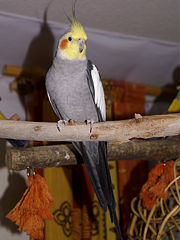 Male
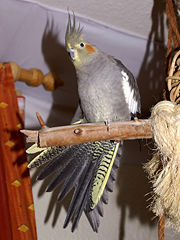 Female
|
||||||||||||||||
| Conservation status | ||||||||||||||||
| Scientific classification | ||||||||||||||||
|
||||||||||||||||
| Binomial name | ||||||||||||||||
| Nymphicus hollandicus (Kerr, 1792) |
||||||||||||||||
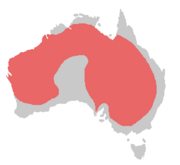 Cockatiel range (in red; all-year resident)
|
||||||||||||||||
| Synonyms | ||||||||||||||||
|
Psittacus hollandicus Kerr, 1792 |
The Cockatiel (Nymphicus hollandicus), also known as the Quarrion and the Weiro, is the smallest and genuinely miniature cockatoo endemic to Australia. They are prized as a household pet throughout the world and are relatively easy to breed. As a caged bird Cockatiels are second in popularity, to only the Budgerigar.[2]
The only member of the genus Nymphicus, the Cockatiel has previously been considered a crested parrot or small cockatoo. However, more recent molecular studies have settled the debate. These indicate that the Cockatiel belongs in the Cockatoo Subfamily Calyptorhynchinae (commonly known as Dark Cockatoos). They are hence now classified as the smallest of the Cacatuidae (Cockatoo family). Cockatiels are natively found across the outback regions of inland Australia, and favour the Australian wetlands, scrublands, and bush lands.
Contents |
Taxonomy
The Cockatiel was originally described by Scottish writer and naturalist Robert Kerr in 1792 as Psittacus hollandicus, before being placed in its own genus Nymphicus by Wagler in 1832. Placed in its own genus, the Cockatiel's scientific name Nymphicus hollandicus reflects the experience of one of the earliest groups of Europeans to see Cockatiels in their native habitat. Travelers thought they were so beautiful that they named them after mythical nymphs. (Nymphicus literally means "little nymph.") The species name refers to New Holland, an old name for Australia.
Its biological relationship had long been disputed; it is now classified into a monotypic subfamily Nymphicinae but had sometimes in the past been misclassified among the Platycercinae, the broad-tailed Parakeets. This issue has now been settled with molecular studies. Mitochondrial 12S rRNA sequence data[3] places it amongst the Calyptorhynchinae (Dark Cockatoos) subfamily. The unique, Parakeet (meaning LONG-tailed Parrot) morphological feature is a consequence of the decrease in size and accompanying change of ecological niche.
Sequence analysis of intron 7 of the nuclear ?-fibrinogen gene, on the other hand, indicates that it may yet be distinct enough as to warrant recognition of the Nymphicinae rather than inclusion of the genus in the Calyptorhynchinae.[4]
The Cockatiel is now biologically classified as a genuine member of Cacatuidae on account of sharing all of the Cockatoo family's biological features. Namely; the erectile crest, a gallbladder, powder down, suppressed cloudy-layer (enabling Lories, Lorikeets (long-tailed Lories), Parakeets and typical Parrot species display of structural colours such as aquas, blues, greens, purples and turquoises), and facial feathers covering the sides of the beak, all of which are rarely found outside the Cacatuidae family.
Portrayal
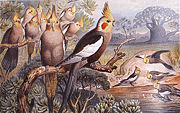
The Cockatiel's distinctive erectile crest expresses the animal's state of being. (Some say "emotional state.") The crest is dramatically vertical when the cockatiel is startled or excited, gently oblique in its neutral or relaxed state, and flattened close to the head when the animal is angry or defensive. The crest is also held flat but protrudes outward in the back when the cockatiel is trying to appear alluring or flirtatious. In contrast to most Cockatoos, the Cockatiel has long tail feathers roughly making up half of its total length. At 300 mm to 330 mm (12 to 13 ins), the Cockatiel is the smallest and only parakeet type of Cockatoo species. The latter ranging between 300 mm to 600 mm (12-24 in) in length.
The "Normal Grey," or "Wild-type" cockatiel's plumage is primarily grey with prominent white flashes on the outer edges of each wing. The face of the male is yellow or white, while the face of the female is primarily grey or light grey, and both genders feature a round orange area on both ear areas, often referred to as "cheek patches." This orange colouration is generally vibrant in adult males, and often quite muted in females. Visual sexing is often possible with this variant of the bird.
Distribution and habitat
Cockatiels are native only to Australia where they are found largely in arid or semi-arid country, but always near water. Largely nomadic, the species will move to where food and water is available.[2] They are typically seen in pairs or small flocks.[2] Sometimes hundreds will flock around a single such body of water. To farmers' dismay, they often eat cultivated crops. They are absent from the most fertile southwest and southeast corners of the country, the deepest Western Australian deserts, and Cape York Peninsula. They are the only Cockatoo species which can sometimes reproduce in the end of their first year.
Lifespan
The Cockatiel's lifespan in captivity is generally given as 15-20 years,[5] though it is sometimes given as short as 10-15 years,[6] and there are reports of Cockatiels living as long as 30 years, the oldest confirmed specimen reported being 35 years old when it died. A cockatiel lived to be 27 years old in Manchester, UK.[7] Diet and exercise, much like in humans, are often major determining factors in cockatiel lifespan. Again, breeders dispute the best diet for increasing the longevity of the cockatiel lifespan. An Oswego, Illinois owner has a healthy normal grey male cockatiel that is a confirmed 29 years 6 months of age.
Aviculture
Cockatiels are generally regarded as good pets having a sweet demeanor, though this is by no means a guarantee. Like most other pets, the manner in which the animal is raised, handled, and kept has a profound effect on the temperament of the animal. Some birds are quite gregarious and sociable while others can be shy, retreating to the back of the cage when an unfamiliar figure appears. If handled often and if they have a patient owner the cockatiel(s) will become tame very quickly compared to some of the other parrot species.
Cockatiels may be permitted to roam freely about a domicile provided the owner takes certain precautions; such as clipping the bird's wings if the rooms have ceiling fans or other hazards that might pose a risk to the bird (stoves, chimneys, toilets, etc.). A scared cockatiel will choose flight over fight most of the time, thus creating a chance for injury (i.e. flying into a glass door). Caged birds should be placed in an area by a window (but make sure the cage isn't completely in direct sunlight for the bird could suffer heat exhaustion) or in any area with a lot of activity during the waking hours, and returned to a secluded area (or have the cage covered) when it is time to sleep. Cockatiels may peacefully nap on or near their owner(s), including the owner's chest and shoulders if the owner is stationary for a long period of time, but it is unsafe for the owner to sleep while the cockatiel is perched on the owner's person as there is a risk of the sleeping owner rolling over and crushing the bird.
Generally, well-socialized birds are gentle and friendly. Some cockatiels enjoy physical contact, lending themselves well to taming. Many cockatiel owners develop regular bonding rituals with their animals, engaging in preening, scratching, and even petting. A cockatiel that wishes to be petted will often lower his head or nibble at the owner's fingers to indicate that it wishes to have its head and neck scratched (two places it can't easily scratch on its own), and will emit a low squawk to show its pleasure. Cockatiels which are hand-fed and purchased from a young age are more readily suited for physical contact.
Some birds will emit a distinctive 'hiss' when irritated, retreating rapidly or defending with pecking bites, which can be relatively strong for their size. This 'hiss' is a form of mimicry from the cockatiel's most common predator, the snake.[8] This hissing may be coupled with the bird tapping its beak on a hard surface to generate additional attention while lowering its head and spreading its wings in a display of aggression.
Cockatiels do have a reputation for being demanding of the attention of their owners on a regular basis. Though noisy at times, their vocalizations range from ginger cheeps to piercing cries but they lack the screeching voice of other parrots (males are the loudest in comparison to the small peeps from a female..[2] A cockatiel that has bonded with an owner may emit vocalizations if that owner leaves the room. Cockatiels permitted to roam freely will often seek out the owner by going from room to room or following the owner around the house; or, if the owner happens to be outdoors, going from window to window to keep the owner in visual range. Well-bonded cockatiels can be trained to accept the absence of the owner by the owner placing the cockatiel on the owner's finger and repeating a key word, such as "bye-bye" or "You be good" several times just before leaving. Cockatiels may also recognize the signs of an owner preparing to go out and train themselves to go into their own cage.
They can be made more secure (in the mood for singing/mimicry, playing, etc) when they have a consistent few hours of quality time per day with a person or in a person's company and a good night's sleep. Twelve hours of sleep at least is required for a happy pet, sleep taken away can cause sickness and grumpy pets. If left on their own, quiet birds will frequently make contact calls with their owners, calls that sometimes can be quite loud if the person is out of sight. Cockatiels can grow so attached to their owners that they may try to 'protect' them from anyone that tries to come near them, such as a partner or family member, by biting or hissing. This happens especially if cockatiels are kept in bedrooms or other rooms that are not generally shared by everyone in the family, because cockatiels perceive those rooms as their own personal territory. By keeping cockatiels in a shared household room, they are exposed to all family members equally and will not favour one person and feel the need to defend him or her as much.[9] Cockatiels must be acquainted with the entire family, in order to assure even temperament toward all.
Their popularity as pets is in part because of their calm and timid temperament, to the point that they can even be bullied by smaller but more confident birds such as Budgerigarsor lovebirds. Budgerigars and other smaller birds may choose to pick at cockatiels' feet causing amputated toes. It is not uncommon at all for a larger or smaller bird to maim the cockatiel, creating life-long disabilities and potentially life threatening injuries. However, some cockatiels will defend themselves.
Cockatiels don't necessarily make good pets for very young children because they startle easily with loud or unexpected sounds and may bite out of fear of sudden hand movements near and above their heads. The shoulders of children are small and unstable perches compared with those of adults, and forcing the bird to use an uncomfortable place to stand may lead to the bird disliking the child. . However, they can make good pets for well-behaved older children. Once bonded with their owners, they will often cuddle and play, pushing their head against hands or faces, tossing small items about for the owner to retrieve as a form of "reverse fetch", or whistling a favorite tune. Cockatiels, like almost all other parrots, love to chew paper and can chew objects (like cardboard, books, magazines, wicker baskets, etc) when left unattended.[10]
Most cockatiels enjoy looking at themselves in mirrors and will engage in the activity for hours. Cockatiels that are exposed to mirrors perceive their reflections as their mates. This can induce very aggressive behaviour, and upon seeing themselves once, they are likely to experience anxiety until they find the mirror again.[11]
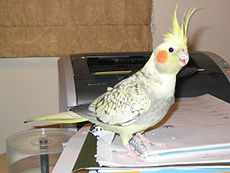
The Cockatiel, along with the Budgerigar, is among the most popular pet bird species(2nd). Today all Cockatiels available in the pet trade are captive-bred, as Australia no longer permits the export of native wildlife, whether endangered or not. As a result, the common way to acquire a cockatiel outside of Australia is to purchase one from a breeder or a pet store.
Often, a cockatiel sold through a pet store will have a toy in its cage when on display. When purchasing the bird, the new owner should also purchase the toy to which the bird has become familiar. This will help comfort the bird as it adapts to its new surroundings. During times when the owner is in the room with the bird, the cage door can be left open and, once the bird has become comfortable with the owner's presence, the bird may exit the cage to investigate the owner. The owner should not force a bird to leave a cage if it isn't ready, as this may cause the cockatiel to be less trusting of the owner.
Captive cockatiels will enjoy most human foods, and should be given unsweetened cereals, rice, carrots, certain fruits, bread, and pasta. Cockatiels should not be forced to eat any food they don't like, and should never be permitted to consume chocolate or caffeine, nor seeds from apples, avocados, peaches, pears, or cherries as the seeds from these fruits are toxic. Cockatiels should also not be given any food that has processed sugar in it, as this can cause the cockatiel to exhibit hyperactivity, aggression, and other behavioral problems.
Cockatiels should be offered a variety of foods to keep the bird on a nutritional diet. One problem that new owners may face is the cockatiel "seed junky"; a bird who only eats millet sprays and seeds. One way to avoid this is to limit the availability of millet seeds (such as offering it as a treat to the bird once or twice a week) and instead offer a mix of pellets, flavored seed balls, dry cereal, cooked spaghetti, rice, and other foods. Cockatiels can eat small pieces of freshly cooked lean beef, chicken or fish; tofu; pet biscuits, and any vegetable that is meaty, dark green, orange, or yellow (high in vitamin A) such as: carrots; sweet potatoes; beets; broccoli; legumes/beans; frozen mixed vegetables; kale; greens (not lettuce); green peppers; zucchini and other squash; asparagus; ripe tomatoes; dried hot peppers; bean or alfalfa sprouts; spinach; and Brussels sprouts. Make sure that any vegetable offered to a cockatiel is cleaned well, as small amounts of pesticides may remain from the harvesting of the produce. Such pesticides are toxic to the bird.
Food should be offered to the bird at room temperature. It is common for a cockatiel to reject a sample of spaghetti if the food is too warm; and then to feast on the pasta strings once it has cooled.
When introduced to a new food, your cockatiel may show no interest in it, but try again another day. It's also important to start with small-size pieces, or your bird may not recognize it as food.
Vocalisation
Although cockatiels are part of the parrot order, they are better at imitating whistles than speech. Males may learn to whistle different tunes. Although they can learn words, the only understandable parts of the words are the inflections, while the consonants are not easily discernible. Their whistles and other mimicking sounds such as 'lip-smacking' and 'tutting' are almost perfect imitations of the sounds their owners make. . Although some cockatiels do learn to repeat phrases, males are generally better at mimicry than females. Cockatiel speech often comes out as a "whistle" when they do annunciate, the voice being soft in volume and difficult to make out. Cockatiels can mimic many sounds, such as the bleep of a car alarm, a ringing telephone, the sound of a zipper, the beeping of cell phones or microwaves, or the calls of other bird species such as blue jays or chickadees and loud weather like thunder. They can also mimic other pets such as dogs, occasionally barking back.
Although female cockatiels are not often known to speak, this is not an absolute. Males have been known to mimic noises, words and sometimes other animals. Females generally don't imitate speech, but tend to mimic sounds such as telephones, washing machines, toilet flushes, etc. Cockatiels that do imitate speech will usually mimic frequently heard phrases, particularly of the individual to whom the bird feels closest.
Cockatiels can also recognize sounds, such as the sound of the owner's vehicle as it parks nearby.
Breeding
Cockatiels are a popular choice for amateur parrot breeders along with budgerigars. This is due to both the ease of getting the birds to breed (they seem to have no inhibitions, with both genders engaging in self-stimulation) and the fairly low cost of the equipment needed. Generally a clutch consists of 4-5 eggs, each approximately the size of one's thumbnail. Eggs are laid once every two days and incubated for 18-22 days. Hatchlings fledge between 4-5 weeks old and wean between 8-10 weeks old. Babies may often be gently handled while in the nest or removed for hand-feeding at 2 or 3 weeks old to help them become more tame and trusting. Puberty (adolescence) is reached around 9 months of age while adulthood is reached around 1 year and 9 months in males and/or 15-18 months in females.
Male cockatiels are very protective and nurturing of their offspring and are known to be very capable of raising their newborns if the mother is unable to.
Some female cockatiels also lay eggs without fertilization, much as those of the chicken species used for food production. In this event, the owner should leave the eggs alone until the bird stops sitting on them, after which the eggs can be removed. To prevent laying, one can keep the cockatiel in more darkness per day by covering it earlier in the evening and leaving the cage covered longer in the morning. Like all parrots, cockatiels of either gender can grow to see their owner or a toy as a mate, engage in courtship and mating behavior including territoriality, and females may lay infertile eggs.
It has been suggested by some breeders that petting the back of the female cockatiel may inadvertently sexually stimulate the hen, promoting egg-laying, and that owners seeking to avoid egg-laying should avoid this particular form of bonding.
The cockatiel has recently been shown to be capable of hybridising with the Galah, producing offspring described by the media as "Galatiels".
Colour mutations
About fifteen primary mutations have been established in the species and enable the production of many different combinations.
Note : aka stands for also-known-as, cka stands for commonly-known-as ika stands for incorrectly-known-as
- ADMpied (aka Recessive Pied aka Harlequin)
- Ashenfallow (ika Recessive silver)
- Bronzefallow (cka Brownfallow)
- Cinnamon
- Dilute (ika Pastel Silver)
- Dominant silver (aka Ashen Dilute)
- Edged dilute (ika Spangled ika spangled silver)
- Faded
- SL Ino
- NSLino (Recessive Ino)
- Opaline (cka Pearled)
- Palefaced (ika Pastelface)
- Platinum (ika Pallid)
- Whitefaced (same gene as genuine Blue mutation in typical Parrot and Parakeet species)
- Dominant and Sex Linked Yellowcheeked
- Yellow-suffused (ika Emerald, or Olive)
The multiple names for these mutations is due in part to different regions of the globe naming the same colour change a different term. This does not mean that it is a different mutation. It only means it is a different name.
Colour mutations are a phenomenon occurring in captivity.
Gallery
Footnotes
- ↑ BirdLife International (2008). Nymphicus hollandicus. 2008 IUCN Red List of Threatened Species. IUCN 2008. Retrieved on 2008-10-25.
- ↑ 2.0 2.1 2.2 2.3 "Factsheets:Cockatiel". Australian Museum. Retrieved on 2008-08-30.
- ↑ Brown, D.M. & Toft, C.A. (1999): Molecular systematics and biogeography of the cockatoos (Psittaciformes: Cacatuidae). Auk 116(1): 141-157.
- ↑ Astuti, Dwi (2004): A phylogeny of Cockatoos (Aves: Psittaciformes) inferred from DNA sequences of the seventh intron of Nuclear ?-fibrinogen gene. Doctoral work, Graduate School of Environmental Earth Science, Hokkaido University, Japan.
- ↑ cockatielcottage.net
- ↑ letstalkbirds.com
- ↑ Petlovers.com
- ↑ ""Behavioral Mimicry in the Titmice (Paridae) and Certain Other Birds" - elibrary.unm.edu". Retrieved on 2008-11-13.
- ↑ (http://www.birdtricks.com/cockatiel-cages.html)
- ↑ (http://www.birdtricks.com/cockatiel-common-problems.html)
- ↑ (http://www.cockatielcottage.net/questions3.html)
References
- Astuti, Dwi (2004?): A phylogeny of cockatoos (Aves: Psittaciformes) inferred from DNA sequences of the seventh intron of nuclear β-fibrinogen gene. Doctoral work, Graduate School of Environmental Earth Science, Hokkaido University, Japan. PDF fulltext
- BirdLife International (2004). Nymphicus hollandicus. 2006 IUCN Red List of Threatened Species. IUCN 2006. Retrieved on 6 May 2006. Database entry includes justification for why this species is of least concern
- Brown, D.M. & Toft, C.A. (1999): Molecular systematics and biogeography of the cockatoos (Psittaciformes: Cacatuidae). Auk 116(1): 141-157.
- Flegg, Jim (2002): Photographic Field Guide: Birds of Australia. Reed New Holland, Sydney & London. ISBN 1-876334-78-9
- Martin, Terry (2002). A Guide To Colour Mutations and Genetics in Parrots. ABK Publications. ISBN 0-9577024-6-9.
- Hayward, Jim (1992). The Manual of Colour Breeding. The Aviculturist Publications. ISBN 0-9519098-0-0.
External links
- Cockatiels at the Open Directory Project
- Genetics and heredity of the Whiteface Lutino cockatiel
- Martin Rasek's Cockatiel Parakeet's Genetic calculator
- Inte ONSMAN's MUTAVI Research and Advice Group
- Clive Hesford's Cockatiel Parakeet section from The Genetics of Colour in the Budgerigar and other Parrots website